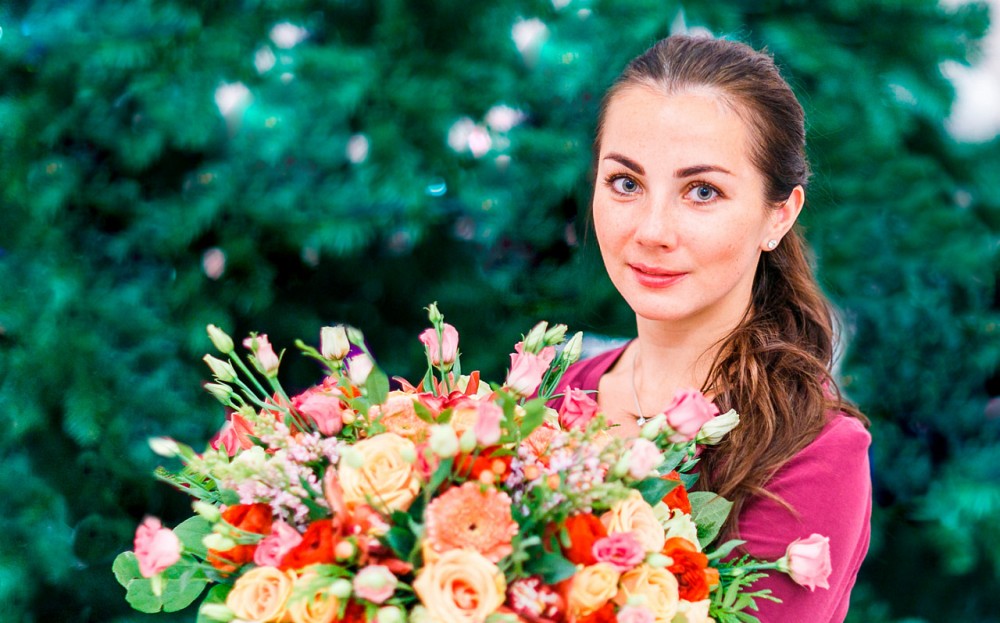Interview with the head of the Ballet School

"VDNKh perfectly reflects my ideas about where to practice such a wonderful form of art as ballet."
Pavilion 62 on Lipovaya Alley is a 1950s building with elements of antique architecture and a central cube made of tempered glass. Like many buildings at VDNKh, it changed its name and purpose several times, and in the middle of the last century, a nuclear reactor was even shown here (the pavilion was called “Atomic Energy for Peaceful Purposes”). In June 2017, the International Ballet Center was opened in the building. We met with its founder and director Elena Kaburneeva and found out at what age it is better to start choreography, how pointe shoes can harm, and how ballet and VDNKh are connected.
How did you come up to the idea to open your own ballet school?
This is my dream from about 11 years old, from the time of my apprenticeship within the walls of the Moscow State Academy of Choreography. You need to understand that in the professional ballet world everything is pretty tough, there is a constant dropout, every day you need to work hard. First of all, this concerns not physical, but moral stress. Then the thought came to my child’s head that when I grow up, I will try to open an alternative ballet school in which absolutely anyone can enjoy dancing and reveal their creative potential. Our center employs teachers of ballet schools and the best theaters, but we do not release ballet dancers for the professional stage. Our goal is for ballet to be a fairy tale for both children and adults.
What is the best age to start classes?
Previously, it was believed that 4 years age is the best age to start classes, when the child is already able to concentrate on the teacher and maintain attention. Now children are different: someone even at 2.5 years old behaves well in the classroom, listens to the teacher and feels calm outside the home environment, and someone else needs to grow up. Therefore, we always conduct trial sessions and then seriously talk with parents about their child’s readiness to work in a group. But the age limit has nevertheless shifted: today the ideal age when it is worth giving a child to ballet is 3 years. The smallest lesson lasts 40 minutes, for children 5-7 years old – 60 minutes, and from 8 years old – an hour and a half.
Who teaches you?
I work only with those teachers who have received a professional ballet education, have worked or combine teaching at the IBC with their main work in academic theaters. In addition to professional qualifications, human qualities are also important for me – responsibility, interest, the ability to inspire and motivate students by own example. Sometimes you need to stay once more after class, talk with parents, pay attention to the nuances – all this can play an important role in the life of a young talent.
How do you select students?
We take everyone who dreams of getting closer to ballet art. We accept students from the age of 2.5, while in professional institutions, the first grade is enrolled from the age of 10. That is, the IBC is also preparing for a professional level, we have special classes for children with ballet skills: the child begins to engage in rhythm, gymnastics, choreography, learns to hear music and keep himself on stage. For children of this age, we become a good base for their further creative path. There are classes for children and adults who do not choose ballet as their profession, but want to dance, become more flexible, have good posture and, of course, post beautiful photos in a tutu skirt and splits on Instagram (laughs – editor’s note). Moreover, the rooms where the classes are held are really inspiring. It is always noticeable whether a person was engaged in choreography or not.
Let’s say your parents decide to send your child to your school. What do they need to take for the first lesson?
For the first, trial lesson, the main thing is that you have ballet shoes on your feet, because in all the halls we have a professional ballet covering. The ballet floor is not a laminate on concrete, there is a 10-centimeter space under you, and the upper layers after the jump cushion, softening the landing. Everything is done here, as in academic theaters – children immediately get used to good things, but practicing in socks or Czechs on such a floor is traumatic. Clothes can be any, the main thing is that it is comfortable and stretchy: this way the teacher will be able to assess the natural physical characteristics of the child, his physiology of bones and muscles. If, after a trial lesson, you decide to continue, then you will have to buy a swimsuit, skirt and tights. Hairstyle – ballet bun. It is important that during the lesson the hair does not bother or distract a child. They must be pinned or removed. Headbands, chains, glasses are prohibited in the ballet hall – this can be traumatic. You can always read more about how to prepare a child for classes on the official website of the ICB (https://balletcenter.ru) and on our pages in social networks.
Ballet shoes, Czech shoes … But what about pointe shoes?
Pointe shoes are a very important question. Our most important rule is not to harm! I am opposed to putting kids on pointe shoes: bones are formed, a person grows. This is extremely unprofessional. At the Ballet Center we begin to get acquainted with pointe shoes only from the age of 8, at first literally 5-10 minutes of the lesson, holding the bar with both hands. You cannot fully engage in pointe shoes before 10 years, and you do not need to strive to get up on them as quickly as possible. Of course, your kids will stand on pointe shoes because the weight is small – but how will they get up? At random! And then all this will be remembered, because there is muscle memory. It is easier to teach than to retrain, so there is no need to rush. It is better to dance beautifully and correctly in ballet shoes, clearly understanding where your heels are, how you stand on your foot, how the center of gravity of the body is transferred, and so on, than jumping on your “toes” incorrectly. Everything will succeed, for this there is a system of choreographic education, developed over the centuries. The order of exercises is regular and consistent.
We talk about girls all the time – a skirt, pointe shoes. Do parents bring boys to your class?
Yes, although there are much fewer of them. We try to groom and cherish our princes, nutcrackers. At first, both girls and boys study together, but then the classes are divided.
Do you have inclusive programs?
We are extremely interested in the development of special programs at the IBC, participation in scientific and practical conferences, round tables and communication with experts on this issue. At the opening of the IBC, we devoted an open lecture to the topic of inclusive education and a subsequent conversation with the parents of the future stdents of the center. Today, special children participate on an equal basis with other regular students in annual performances, actively attend master classes. Naturally, such projects are the result of well-coordinated interaction between qualified doctors and our teachers. The goals may be different – this is either just adaptation and overcoming the fear of the world around them, or work through dance, choreography, music on specific features (physical or psychological), but it is quite obvious that dance education has a beneficial effect on such children.
Do you have adults attending classes?
Undoubtedly. Classes for adults are a separate area. Groups of various levels of training have been formed. We are visited by aspiring stars of the center who want to fulfill their childhood dream of becoming a ballerina and dancing on stage, and professional dancers who, for various reasons, stopped their dancing careers and now want to resume classes to maintain or gain shape. Most of them. Many people just love ballet as an alternative to boring fitness. In the ballet class, you can in a good mood, to the music, improve stretching, make a “ballet back”, lose weight, work on flexibility, plasticity. All muscle groups are being worked out: legs, arms, back. Our most experienced student is 63 years old and looks great. Another proof that working at the machine is a charge of beauty, longevity and well-being. No wonder our great ballerinas, the same Maya Mikhailovna Plisetskaya, did not stop their studies at the age of 80.
Why did you open a school at VDNKh?
VDNKh is the largest exhibition of the country’s achievements. And ballet is the pride of Russia, our visiting card, a national cultural treasure. I was lucky to open the center right here, in a unique building, an architectural monument, which completely occupies the IBC. Pavilion No. 62, when I first came here, reminded me of the era of imperial Russia, the Institute for Noble Maidens, of the time when ballet was practiced in halls with six-meter ceilings, panoramic windows overlooking the garden, and luxurious chandeliers. Within the walls of the pavilion, you immediately understand what kind of art you came to do. I immediately want, without the teacher’s advice, to keep my back straight and behave differently, not like in the corridors of an ordinary school. VDNKh perfectly matches my ideas about what ballet is and where they need to practice.
What do you personally associate with VDNKh?
My association with VDNKh is a huge park, beautiful fountains, something close to Peterhof. I am very glad that our ballet school is located in a park area. At any time of the year, especially in spring, it is just wonderful here.
Was it difficult to adapt the former pavilion “Nature Conservancy” for ballet classes?
You know, when I got here for the first time, everything was in a rather poor state.
This is a long, separate story about the meticulous restoration, adaptation and opening of a ballet school. I am very grateful to the people who believed in my idea to open a ballet center here and helped me to implement it. This includes the leadership of VDNKh, restorers, builders, and architects. In 2017, within the framework of the International Cultural Forum in St. Petersburg, a solemn presentation of the Phoenix honorary prize for achievements in the field of preserving the cultural heritage of Russia took place. Our International Ballet Center became the winner in the nomination “For the best implemented project for the preservation and adaptation of cultural heritage sites.” Also at the Moscow Restoration competition, our efforts were noted by the Department of Cultural Heritage of the city of Moscow with gratitude for investment in restoration work at a cultural heritage site of federal significance.
Source: http://vdnh.ru/news/vdnkh-kak-nelzya-luchshe-otrazhaet-moi-predstavleniya-o-tom-gde-nuzhno-zanimatsya-takim-prekrasnym-v/


